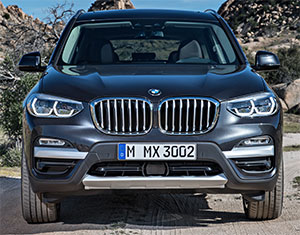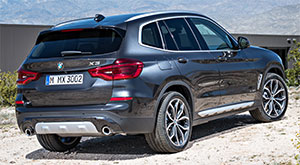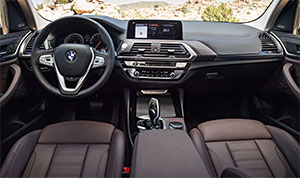2018 BMW X3
We tested the original BMW X3 sports activity vehicle back in 2003. We marveled at how the brand’s second utility managed to add boat-loads of everyday comfort and versatility while maintaining so much of its namesake 3-series sport sedan’s concise driving character. Now, as the 3rd generation X3 has arrived, it’s time to take stock of BMW’s compact ute once again, and see just how it’s evolved.
BMW jumped into the premium utility market before most. They were a true early adopter in embracing the new “utilitarian” norm for luxury carmakers. But, the 2018 X3 drives into a much more crowded automotive landscape than the original did, with rival luxury utes at every turn. Still, BMW didn’t want to mess too much with success.
So, they kept the new X3’s exterior dimensions almost the same as the outgoing model. Yet, they stretched the wheelbase by over two inches for additional interior space.
 That’s because its lesser sibling the X1, which has the advantage of being front-wheel-drive based, had almost the same amount of room inside as the out-going rear-drive based X3.
That’s because its lesser sibling the X1, which has the advantage of being front-wheel-drive based, had almost the same amount of room inside as the out-going rear-drive based X3.
But behind the wheel, there’s no comparison. While the X1 is indeed very fun to drive, it’s more like a lightweight, nimble plaything, whereas the X3 feels solid and nailed down; yes still very much like a 3-Series sedan.
And, since BMW does place such a high priority on that driving experience, it’s notable that an M Performance model is newly available in the X3.
The M40i, which replaces the xDrive35i, features BMW’s 3.0-liter turbo inline-6, outputting 355-horsepower and 369 lb.-ft. of torque, an 8-speed automatic transmission, and more rear-bias for the standard xDrive all-wheel-drive system.
It does indeed feel powerful, but like any performance machine, things can be loud and a bit abrasive at times.
M40i’s get sportier-looking trim inside too, as well as an aero kit for the exterior; where you’ll also notice black chrome tips for the performance exhaust system, M Sport brakes, and 19, 20, or 21-inch wheels.
 But, we also spent time in the much higher volume xDrive30i, which replaces the xDrive28i base model. Under its hood, is a slightly updated 2.0-liter I4 turbo; now with 248–horsepower, 8-more than before, and 258 lb.-ft. of torque.
But, we also spent time in the much higher volume xDrive30i, which replaces the xDrive28i base model. Under its hood, is a slightly updated 2.0-liter I4 turbo; now with 248–horsepower, 8-more than before, and 258 lb.-ft. of torque.
It ramped us to 60 in 6.5-seconds. Really good for any “base model” utility. The M40i does the same deed about two seconds quicker.
All-wheel-drive grip, and easy to use launch control, get you off the line efficiently; while the 8-speed automatic that comes with all X3s, snaps off shifts with an almost brutal immediacy, that keeps the turbo-4 in its sweet spot for the whole ¼-mile trip, which takes 15.0-seconds at 90 miles-per-hour. It may not be the absolute fastest SUV out there, but it feels like it.
Weight is also virtually the same as last year, but it has been shifted around, with a little more now supported by the rear wheels for improved handling.
Even more so here in the 30i where turn-ins are deadly quick, and body roll comfortably minimal. You do have to keep inputs smooth however, as stability control is quick to trigger.
 Two thumbs up for braking, as stops from 60 averaged just 102-feet. A firm pedal with short travel leads to a comfortable and reassuring feeling. All-in-all a very well-balanced package.
Two thumbs up for braking, as stops from 60 averaged just 102-feet. A firm pedal with short travel leads to a comfortable and reassuring feeling. All-in-all a very well-balanced package.
With X1 now taking up entry-level SAV duties, even the base X3 gets much nicer materials throughout the cabin, part of a pleasant overall evolution to the familiar layout inside. The dash-top touchscreen now stretches over 10-inches, and the available Head Up Display is 75% larger than before.
Very minor changes to cargo capacity, with rear space up slightly to 28.7 cubic-ft., while overall volume with rear seats folded, falls just a tad to 62.7 cubic-ft.
This X3 is also the first BMW utility to offer a factory-installed trailer hitch. Towing capacity is good for a compact, at 4,400-lbs.
Government Fuel Economy Ratings for the 30i are 22-City, 29-Highway, and 25-Combined; our average was a disappointing 23.3 miles-per-gallon of Premium. Still, there’s an average Energy Impact Score of 13.2-barrels of yearly oil use, with C02 emissions of 5.9-tons.
X3 pricing starts about the same as before, with an xDrive30i at $43,645. M40i’s begin at $55,495.
Keeping performance high on the priority list, while bringing more utility and luxury along for the thrill ride, will surely keep the 2018 BMW X3 a popular choice, we also think the X3 has evolved enough for many of them to continue to look on with envy.
Specifications
- Engine: 3.0 liter (xDrive35i) / 2.0 liter (xDrive30i)
- Horsepower: 355 (xDrive35i) / 248 (xDrive30i)
- Torque: 369 lb.-ft. (xDrive35i) / 258 lb.-ft. (xDrive30i)
- 0-60 mph: 6.5 seconds (xDrive30i)
- 1/4 mile: 15.0 seconds @ 90 mph
- EPA: 22 mpg city / 29 mpg highway (xDrive30i)
- Energy Impact: 14.2 barrels of oil/yr
- CO2 Emissions: 5.9 tons/yr
2024 Toyota Land Cruiser
Toyota’s Go Anywhere Globetrotter Returns To U.S.
Every once in a while, we all need a reset. A time to get back to basics and prioritize the things that really matter. Well, for the Toyota Land Cruiser that time is now. So, let’s find out if that means bigger and better things for Toyota’s iconic off-roader.
The Toyota Land Cruiser’s status among the global off-road community is legendary, and it’s hard to imagine there’s any corner of the earth where a Land Cruiser hasn’t kicked up a little dust or mud. Well, 2024 sees the return of the Land Cruiser to the U.S. market after a 3-year hiatus, getting a major reset for the journey.
The reset comes mostly by no longer being based on the large three-row “300-series” chassis, but a new version of the smaller “200-series,” now known as the J250. As with the latest Tacoma, it uses the Tundra pickup’s full-size steel frame.
While the main Land Cruiser model, which goes by simply Land Cruiser, is packed full of luxury and convenience features, there is also a stripped-down model known as the 1958, honoring the first year the Land Cruiser made landfall here in North America. And it is that 1958 we have here, and we were glad to see it, as it also celebrates the original’s back-to-basics approach as a blank canvas for you to personalize as you tackle more and more adventures.
Not that it’s fully stripped down, as 8-inch touchscreen infotainment, a 7-inch full-color multi-information display, and automatic climate control are still standard. Plus, some seriously durable materials, and great heated cloth front seats that throw off some get serious 1990s Tacoma vibes.
But outside, there’s a definite lack of flashy trim and basic looking 18-inch wheels with Yokohama Geolander all-season tires; plus, big chunky bumpers and tilt-up back glass, which is a rarity that we appreciate. Though there is a little too much plastic in places that are sure to see some abuse if you do any significant off-roading.
It even feels a little rough around the edges, but for us it just adds to the rugged old-school utility vibe in a good way.
We did just that, both here in the Mid-Atlantic as well as in the California desert; and while there are some tech-forward driving aids, the actual hardware is in most cases plenty to get things done. That includes standard full-time dual-range four-wheel-drive, locking center and rear diffs, and 8.7-inches of ground clearance. A front stabilizer bar disconnect is also available to allow for increased articulation.
Who needs a V6 or even a V8 when you’ve got Toyota’s i-FORCE MAX setup at your disposal with 326 horsepower and 465 lb-ft of torque coming from a 2.4-liter turbo-four with an electric motor sandwiched between the engine and its eight-speed automatic transmission. Low speed torque delivery is impressive. It even feels a little rough around the edges, which may be a turn off to some, but for us it just adds to the rugged old-school utility vibe in a good way.
And it certainly feels quicker than an off roader needs to be, with an instant torque dump as soon as we eased on the throttle at our Mason Dixon test track; helping us get to 60 in 8.1 seconds and through the quarter-mile in 16.3 seconds at 86 mph. Considering the Land Cruiser’s terrain conquering mission, it behaved quite well in our handling course; it was plenty responsive to inputs, with less body roll than we expected and plenty of grip from the tires. The steering was light and quick but as expected didn’t provide much feel. Other than significant nosedive, braking performance was exceptional. Only 107-feet to panic stop us from 60 mph.
With the shift to the smaller size, there’s no more third row available, and cargo capacity now comes in at 46.2 cubic-feet with a max of a still healthy 82.1. Now, the best part of the Land Cruiser’s return is the entry price of $57,445. That’s about 30-grand less than what the last Land Cruiser went for back in 2021.
Whether it’s over the top fashion trends, mullets, or zombies; just when you think they’re dead, they come roaring back to life. Of course, we’re much happier to see the resurrection of this 2024 Toyota Land Cruiser than any of those things. Toyota is one brand that still recognizes the value of full-framed rugged rigs and has also acknowledged that sometimes less really is more. The Godfather of Toyota off-roading is back and better than ever.







